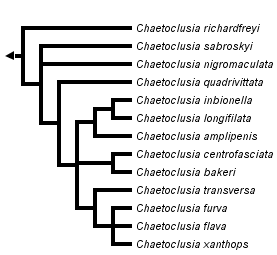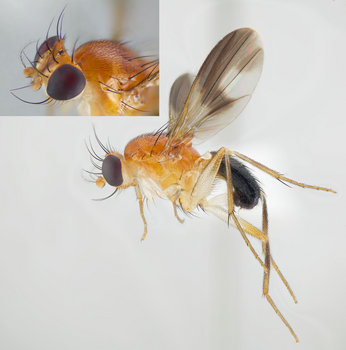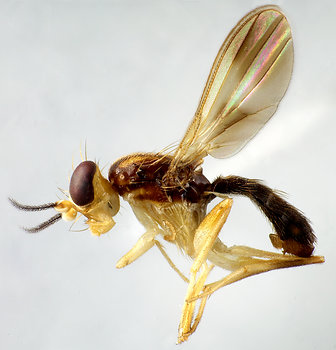Chaetoclusia
Owen Lonsdale and Steve Marshall


This tree diagram shows the relationships between several groups of organisms.
The root of the current tree connects the organisms featured in this tree to their containing group and the rest of the Tree of Life. The basal branching point in the tree represents the ancestor of the other groups in the tree. This ancestor diversified over time into several descendent subgroups, which are represented as internal nodes and terminal taxa to the right.

You can click on the root to travel down the Tree of Life all the way to the root of all Life, and you can click on the names of descendent subgroups to travel up the Tree of Life all the way to individual species.
For more information on ToL tree formatting, please see Interpreting the Tree or Classification. To learn more about phylogenetic trees, please visit our Phylogenetic Biology pages.
close boxIntroduction
Dorsal setulae on vein R1 most readily characterizes Chaetoclusia Coquillett, a small neotropical genus of 13 species that is most diverse in Central America and the Caribbean (Lonsdale & Marshall 2006). Its type species, C. bakeri Coquillett, is widespread in the tropical Neotropics outside of the Caribbean, and is the only species likely to be encountered with any frequency; it is quite easily identified, being the only species in the genus with a densely plumose arista.



Chaetoclusia sabroskyi (Sóos) & Chaetoclusia bakeri Coquillett, 1904. © Owen Lonsdale
Characteristics
Chaetoclusia is most easily identified on the basis of setulae on vein R1 (Lonsdale & Marshall 2006) (one Pacific Czernyola has a few similar bristles at the apex of this vein). A ventrally reduced annulus and a minute anterior lateral scutellar bristle (larger in Chaetoclusia richardfreyi (Sóos)) are also useful for diagnosis, but these states occur independently in a number of Sobarocephala, occasionally in tandem. Black bristles are also synapomorphic of Chaetoclusia, but they are retained in only the most ancestral species. Non-synapomorphic diagnostic characters include a shiny gena (pilose or tomentose in most Sobarocephala), two postsutural dorsocentral bristles, no presutural intra-alar bristle, a dorsal preapical bristle on the mid tibia, and a closed cell bm (open in most other Sobarocephalinae).
Phylogenetics
Chaetoclusia has been revised by Lonsdale & Marshall (2006), providing a phylogenetic analysis and a key to all species. Chaetoclusia is the sister group to the clade containing Sobarocephala + Procerosoma, which is defined by an open cell bm, no presutural intra-alar bristle (also found in the Clusiodinae), and a small pregonite. These three genera make up the subfamily Sobarocephalinae, defined by migration of the sixth spiracle out of the annulus, a ventral lobe of the hypandrium that is usually at least as long as the hypandrial arm (secondarily reduced in several species of Chaetoclusia and Sobarocephala), and a relatively large surstylus.
Lonsdale & Marshall (2006) included the monotypic genera Chaetoclusiella Sóos, 1962 and Trichoclusia Sóos, 1962 as junior synonyms of Chaetoclusia.
References
Lonsdale, O. & Marshall, S.A. 2006. Redefinition of the Clusiinae and Clusiodinae, description of the new subfamily Sobarocephalinae, revision of the genus Chaetoclusia and a description of Procerosoma gen. n. (Diptera: Clusiidae). European Journal of Entomology, 103: 163-182.
Title Illustrations

| Scientific Name | Chaetoclusia furva |
|---|---|
| Specimen Condition | Dead Specimen |
| Identified By | O. Lonsdale |
| Life Cycle Stage | Adult |
| Body Part | Wing |
| View | dorsal |
| Image Use |
 This media file is licensed under the Creative Commons Attribution-NonCommercial License - Version 3.0. This media file is licensed under the Creative Commons Attribution-NonCommercial License - Version 3.0.
|
| Copyright |
© Owen Lonsdale

|
About This Page
Owen Lonsdale

Canadian National Collection of Insects, Arachnids & Nematodes
Steve Marshall

University of Guelph, Canada
Correspondence regarding this page should be directed to Owen Lonsdale at and Steve Marshall at
Page copyright © 2011 Owen Lonsdale and Steve Marshall
 Page: Tree of Life
Chaetoclusia.
Authored by
Owen Lonsdale and Steve Marshall.
The TEXT of this page is licensed under the
Creative Commons Attribution-NonCommercial License - Version 3.0. Note that images and other media
featured on this page are each governed by their own license, and they may or may not be available
for reuse. Click on an image or a media link to access the media data window, which provides the
relevant licensing information. For the general terms and conditions of ToL material reuse and
redistribution, please see the Tree of Life Copyright
Policies.
Page: Tree of Life
Chaetoclusia.
Authored by
Owen Lonsdale and Steve Marshall.
The TEXT of this page is licensed under the
Creative Commons Attribution-NonCommercial License - Version 3.0. Note that images and other media
featured on this page are each governed by their own license, and they may or may not be available
for reuse. Click on an image or a media link to access the media data window, which provides the
relevant licensing information. For the general terms and conditions of ToL material reuse and
redistribution, please see the Tree of Life Copyright
Policies.
- First online 25 August 2005
- Content changed 20 August 2007
Citing this page:
Lonsdale, Owen and Steve Marshall. 2007. Chaetoclusia. Version 20 August 2007 (under construction). http://tolweb.org/Chaetoclusia/27679/2007.08.20 in The Tree of Life Web Project, http://tolweb.org/







 Go to quick links
Go to quick search
Go to navigation for this section of the ToL site
Go to detailed links for the ToL site
Go to quick links
Go to quick search
Go to navigation for this section of the ToL site
Go to detailed links for the ToL site